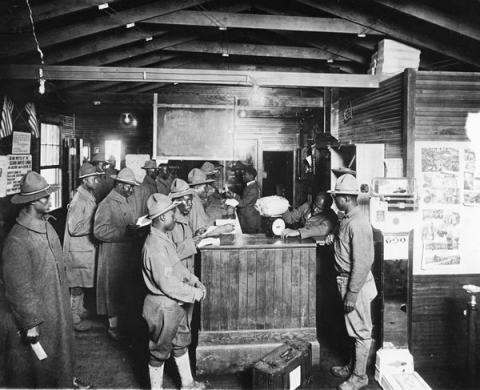During World War I, the U.S. military was so segregated that Stateside African-American soldiers had separate mail facilities. This image depicts a photo maintained by the New York Public Library where it has this description: “Lacking basic mailing rights in the U.S. Army, black soldiers gather at a YMCA facility at Camp Travis, Texas, to send letters and bundles of their civilian clothing back home." Online via Photographs and Prints Division, Schomburg Center for Research in Black Culture, The New York Public Library.
Following World War I, the federal government wanted to assess how various branches of the military service - and the people who staffed those branches - had performed during the war. Beyond a general inquiry, military leaders wanted a specific briefing on the war performance of African-Americans.
In 1925 - about five months before before Bessie Coleman died while testing a new plane - the War College issued its confidential report. The bottom line, of this November 10th analysis, is that African-Americans had a role to play - as part of America's fighting manpower - but there were many important tasks they could not do.
Reading the report with modern eyes, one gets the sense that preexisting prejudice had clouded the vision of military investigators and writers responsible for this document. Many examples support the various findings, but one wonders about their factual basis.
The report, which is not marked "Secret" but was treated as such, is maintained by the National Archives at the FDR Presidential Library and Museum. It contains the official basis for discrimination - leading to sanctioned racism against (and resulting morale problems among) - African-Americans in the military. It explains why the federal government initially refused to allow black pilots to train for aerial combat missions during WWII.
The words are very unsettling, but they must be read in order to understand a major source of prejudice against African-Americans in the U.S. military. From the "Notes" to the 1925 report, which appear at the beginning of the document, we see the following:
Compared to the white man he [a black man] is admittedly of inferior mentality. He is inherently weak in character ("Notes on proposed plan," point 2.)
The negro, particularly the officer, failed in the World War. ("Notes, point 4.)
The Mobilization Plan [to be implemented if future hostilities arise] provides for approximately 140,000 negroes for non-combatant duty. This would leave approximately 30,000 for the experiment of combat duty. ("Notes," point 7.)
The majority of negroes left at home will be in the southern states where they will be needed for labor and where they can best be handled by competent whites. ("Notes," point 8.)
In the report itself, which contains all sorts of opinions, we see statements like these (in the "Opinion of the War College"):
In the process of evolution the American negro has not progressed as far as the other sub-species of the human family. As a race he has not developed leadership qualities. His mental inferiority and the inherent weaknesses of his character are factors that must be considered with great care in the preparation of any plan for his employment in war. (Point 1.)
Negro soldiers as individuals should not be assigned to white units. (Point 8.)
Negro officers should not be placed over white officers, non-commissioned officers or soldiers. (Point 13.)
Negro officer candidates ... should be sheltered, messed and instructed separately from white candidates. (Point 14.)
...If the negro makes good the way is left open for him to go into combat eventually with all-negro units. (Point 16.)
...The plan is believed to be eminently fair to both the negro and the white man. Political or racial pressure should not be allowed to alter it. (Point 17.)
Support for the report, set forth in the "References" section, continues in like fashion. Its impact reached people like Lt. Jackie Robinson - who later broke baseball's "color line" - when, in 1944, he refused to move to the back of a bus (and was thereafter investigated, then court-martialed, at Camp Hood, Texas).
Because discrimination issues could negatively impact America's need to unite in the war effort, the federal government commissioned posters and films to rally the cause. Some featured respected African-Americans and all promoted noble ideas.
With this historical background in mind, we are now ready to examine how the "Tuskegee Experiment" began - and how it fared - when real people were put to the real test during World War II.


 Back
Back
 Next Chapter
Next Chapter

 Back
Back
 Next Chapter
Next Chapter


